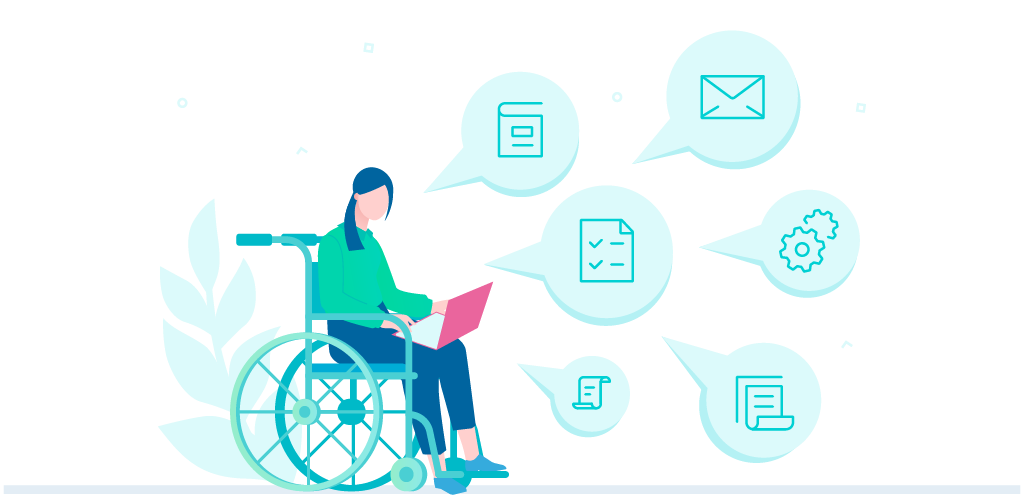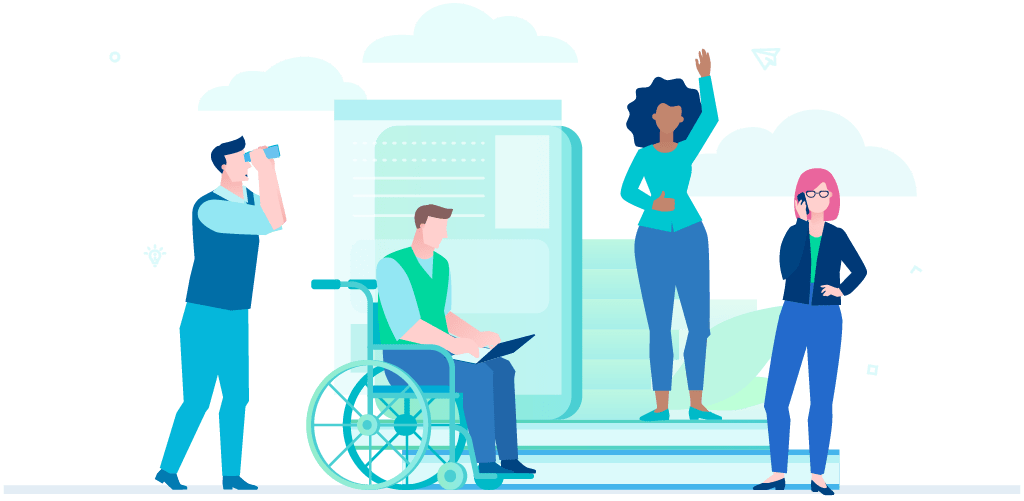
Accessible to inclusive: learning design’s powerful new focus
June 17, 2019
Accessibility in the design of learning, once regarded as an add-on or a set of trade-offs, has given way to a new emphasis on inclusive design. John Helmer talks to Charlotte Iwanejko about how this shift has affected her role as Digital L&D Design Manager at Boots UK.
There’s a radical readjustment going on that is changing how we view difference in the workplace. Where once we talked about making websites and learning programs more ‘accessible’ to disabled users, we more often nowadays place this issue of differing user needs within the wider context of inclusivity.
Inclusive design, says Microsoft, is a methodology that draws on the full range of human diversity and involves ‘including and learning from people with a range of perspectives’. The tech giant, which linked executive compensation to D&I goals in 2016, puts inclusivity at the centre of its design practice and has a wealth of tools and resources for inclusive design on its website.
And Microsoft is far from a lone voice here. This sort of thinking is widespread across the business; part of a wider change to social attitudes manifested in phenomena such as the #MeToo movement.

The world is getting more and more designed
As organisations work through these issues, with HR and L&D often heavily involved, we find that it is often the technology that brings things to a head. As more and more of the services we use every day are automated rather than human-delivered, it means that more and more of our interactions have to be designed, often by people remote from the context of use.
While humans will instinctively micro-adjust their behaviours according to the situation and who they are interacting with, machines can only do what they’re told. A lot of human behaviour is driven at a barely conscious level, but machines have no subconscious, no tacit knowledge, no intuition. With machines, everything has to be made explicit at the outset. And what this exposes, all too clearly, is failures in the design process when the true diversity of human beings are not factored in.
If designers, developers and business leaders think too narrowly, individual and institutional biases can become ‘baked in’ to the design of systems and products, with effects ranging from embarrassing to offensive – and even downright life-threatening.
The ‘racist’ soap dispenser that fails to recognise the hands of black users has become a staple of conference presentations. Products from ‘sexist’ airbags to stab vests are seen to be dangerous for women because designed with the male body shape (and only the male body shape) in mind.
But there is also a positive aspect of the machine’s lack of a subconscious. AI researcher Joanna Bryson of Bath University reports that talking to HR people in large companies under Chatham House rules about using AI to sort resumes (CVs) has given them much better results for recruitment. However, nobody wants to document this, the reason being that to do so would make public the implicit bias that was showing up previously – so that, for instance, people with BAME names would be much less likely to be selected for interview.
Getting machines to automate ‘thinking’ processes forces us to be explicit about biases that were previously implicit; biases no one wants to go on the record as having (although the data clearly shows they exist). AI could, therefore, notionally, make us more virtuous in acting on our avowed, publicly stated values.
Whether the rapid march of AI is to be feared or welcomed, however, these debates show that there is no ignoring the importance of inclusivity in design. With our ever-more-powerful technology tools, we are building a new world. But will it be one in which we can all live and thrive?
Suddenly accessibility seems like a much bigger issue.

Innovation comes from variation
What is striking about the new language of inclusivity for someone like myself, who has been writing articles and white papers on accessibility in learning since the early years of the century, is how it widens the focus beyond the disability spectrum (cognitive, hearing, motor and vision) to also include gender, demographics, ethnicity, etc. as important considerations for designers.
In fact, disability seems to be collapsing as a category, with the perception growing that disability should not be considered a characteristic of certain people but is created by environments designed in a non-inclusive way. There is no such thing as ‘normal’, and no ‘average user’ we should be designing for. Responsible design is not about throwing out lifelines to stragglers so that they can keep up with the rest of us: instead, it recognises the strength in diversity and its potential benefits for the bottom line.
‘Designing for people with permanent disabilities actually results in designs that benefit people universally. Constraints are a beautiful thing.’ (Microsoft)
‘Innovation comes from variation’ (Joanna Bryson)
It’s a change of perspective. Times change and social attitudes shift with them. And learning designers are responding to this change.
Charlotte’s story
‘I think it’s good because it’s taking a more positive look rather than a negative one,’ says Charlotte Iwanejko of Boots UK, a Learning Pool client. ‘In the past you’d have to strip things out to make more accessible, but if you’re designing inclusively it feels more positive.’ Charlotte heads up a team to design digital learning across Boots UK and its multiple brands, and also to support other learning designers in building their digital skills. She’s witnessed the shift in her eight years at Boots.
From an agency background, on the ‘vendor’ side, accessibility has always been there for Charlotte. She’s seen designing for the disability spectrum become easier as accessibility features have increasingly become embedded in authoring environments like Adapt – which has recently added a helper extension for dyslexia. ‘We may have made some small tweaks to some learning for colour contrast issues in the past, but more and more the tools that we use help us to be accessible without having to think about it too much.’

In certain circumstances, such as in work done with external partners, for instance, in the healthcare sector, there might be specific accessibility requirements. However, by and large, accessibility has become business as usual for designers like Charlotte.
But if accessibility considerations have to a large degree been taken care of by software, can we automate inclusivity in the same way? Talking to Charlotte it’s clear that inclusivity requires a broader focus. It’s not a matter of design practice like accessibility, but something that comes out of the culture of the organisation.
Boots UK has an explicit commitment to workplace diversity. These words are from the retailer’s website: ‘Ensuring that we are always recruiting, retaining and promoting a diverse mix of colleagues who are representative of the diversity in our local communities gives us a great opportunity to have access to a broad range of ideas and allows us to give you the wide mix of products you know and expect from Boots.’
The Boots UK workforce is 79% women, reflecting perhaps the nature of its products and markets. When Charlotte joined, the retailer was in its Here Come the Girls’ era of advertising. Since then, the company’s adverting has developed to embrace new perspectives. For its ‘faceless’ campaign, according to marketing website The Drum: ‘Instead of working with professional models, Boots plumped to use an array of different personalities including Michelle, a Boots No7 in-store advisor; influencer Em Ford; journalist, dancer and amputee Kat Hawkins; and male vogue dancer Busola Peters’.
‘There’s a lot of diversity in our advertising,’ says Charlotte proudly; ‘and you should be able to see the same diversity throughout the design of our learning materials’. Inclusivity seems to come out of the organisation’s values in a natural, organic way.
She gives the example of a new initiative in L&D, which seeks to build and encourage specialisms in the workforce, spelling an end to ‘sheep-dip’ training. Despite her evident enthusiasm, she can’t tell me much more than that, as it’s still in development. Watch this space.
Finally, I ask her to sum up her experience of inclusivity at Boots UK.
‘I’ve been pretty impressed … it’s nice to work for a company that is at the forefront of these issues – in those things that we’re seeing through the public-facing things like ads, but also in its reflection back through the business.’
Sources
https://learningpool.com/products/adapt-builder/
https://www.theguardian.com/lifeandstyle/2019/feb/23/truth-world-built-for-men-car-crashes
https://www.microsoft.com/design/inclusive/
https://www.businessinsider.com/microsoft-inclusion-employee-review-process-2019-1?r=US&IR=T
About the authors
John Helmer FLPI is an experienced communications expert specialising in digital industries and emerging technologies, particularly in learning, HR & education.
Working for many of the leading companies in the learning technologies space, he has striven to connect buyers and vendors in furthering mutual understanding. He created and edited the influential Curve Magazine and Learning Lounge events, and developed the brand for self-directed learning service, me:time.
As a consultant, he has developed strategies and thought leadership programmes on behalf of corporates, not-for-profits and public bodies. He is an active blogger, a published novelist and columnist, and appeared on Top of the Pops.
Got a learning problem to solve?
Get in touch to discover how we can help

